Common Problems in Plants
Mar 28, 2025
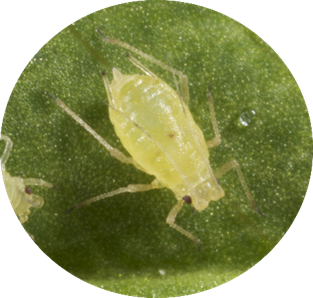
Aphids
What to look for: Reduced growth, honeydew, and their common companion: ants!
Reproduction: Significant rate of reproduction.
Biocontrol tips: Success using biocontrols requires an early start and regular maintenance.
Home Remedies: A simple mixture of liquid dish soap and water can be sprayed on plants to suffocate pests. Neem oil and other essential oils are a natural repellent and pesticide that can be mixed with water and liquid soap to create a spray for pests. Diatomaceous Earth is also effective, the abrasive substance can be sprinkled around plants to dehydrate the exoskeleton of insects.
Natural Solutions:
Chrysopa (Chrysoperla carnea): The larvae of green lacewings are voracious predators of aphids, consuming large numbers quickly. They also prey on other problems like spider mites, thrips, and whiteflies.
Aphipar (Aphidius colemani): This wasp parasitizes over 40 species of aphids. It lays eggs inside aphids, and the larvae consume the aphids from within, effectively controlling aphid populations.
Aphidend (Aphidoletes aphidimyza): The larvae of aphid midges are effective predators of over 60 species of aphids. They paralyze aphids and suck them dry, providing efficient aphid control in greenhouses and outdoor crops.
Aphipar-M (Aphidius matricariae): This wasp targets green peach aphids and other related species. It is effective year-round and can locate new aphid colonies even when populations are low.
Ervipar (Aphidius ervi): This wasp is effective against larger aphid species like the potato aphid. It parasitizes hundreds of aphids, significantly reducing their populations.
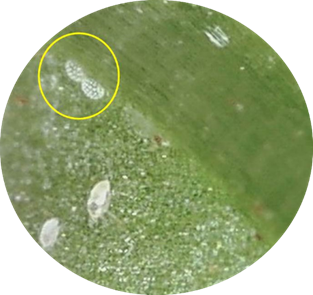
Broad Mites
What to look for: Distorted growth.
Identification: Small size makes ID difficult. Eggs are covered in 'jewel-like' tubercles.
Home Remedies: Pruning and removing affected plant parts can help reduce the mite population. Increasing humidity around the plants can also deter broad mites. A simple mixture of liquid dish soap and water can be sprayed on plants to suffocate pests. Neem oil and other essential oils are a natural repellent and pesticide that can be mixed with water and liquid soap to create a spray for pests. Diatomaceous Earth is also effective, the abrasive substance can be sprinkled around plants to dehydrate the exoskeleton of insects.
Natural Solutions:
Anso-Mite – Predatory Mite for Thrips and Mite Control: This product contains Amblyseius andersoni, a predatory mite that targets broad mites and other mite species. It is effective in diverse climates and helps maintain pest populations at low levels.
Swirski-Mite Ulti-Mite (Predatory Mite): Amblyseius swirskii is effective in controlling broad mites by preying on their eggs and larvae. Swirskii's main targets are Thrips, whitefly and mite species making it a versatile biocontrol agent.
Spical Ulti-Mite (Predatory Mite): Amblyseius californicus is a predatory mite known for its ability to control spider mites and other mite species. It is highly effective in both greenhouse and outdoor environments.

Fungus Gnats
What to look for: Gnats with distinct 'Y' vein on wings.
Larvae: Black-headed larvae, which feed on roots.
Attraction: Fungus gnats are attracted to persistently wet soils.
Home Remedies: Allow the soil to dry out between waterings to reduce the gnat population. A simple mixture of liquid dish soap and water can be sprayed on plants to suffocate pests. Neem oil and other essential oils are a natural repellent and pesticide that can be mixed with water and liquid soap to create a spray for pests. Diatomaceous Earth is also effective, the abrasive substance can be sprinkled around plants to dehydrate the exoskeleton of insects. Sticky traps can also be used to catch adult gnats.
Natural Solutions:
Entomite-M (Predatory Mite): This product contains Stratiolaelaps scimitus (formerly Hypoaspis miles), a predatory mite that lives in the top half inch of soil. It preys on fungus gnat larvae, thrips pupae, and other soil-dwelling pests. These mites are effective in both greenhouse and outdoor environments, providing long-term control by breaking the life cycle of pests.
Entonem (OMRI): This product uses Steinernema feltiae, a beneficial nematode that parasitizes fungus gnat larvae. It enters the larvae through body openings and releases symbiotic bacteria that kill the host within 24-48 hours. This nematode is effective in reducing fungus gnat populations and can also target other soil-dwelling pests such as thrips, beetles, and caterpillars.
Atheta (Rove Beetle): This product contains Dalotia coriaria (formerly Atheta coriaria), a predatory beetle that preys on fungus gnat larvae and pupae. It is highly mobile, able to crawl or fly from pot to pot, and is effective in various growing conditions, including hydroponic systems. This beetle also helps control root aphids and thrips.
Isarid Mycoinsectide: This product contains a fungal pathogen that infects and kills fungus gnat larvae. It is a broad-spectrum biocontrol agent that also targets other pests such as whitefly, aphids, thrips, mealybugs, weevils, lygus, leafhopper, and engytatus, providing a sustainable and environmentally friendly pest management solution.
Capsanem (Nematode, OMRI): This product uses Steinernema carpocapsae, a beneficial nematode that targets fungus gnat larvae. It waits for prey to wander by and then enters the host through body openings, releasing bacteria that kill the host. This nematode is effective in controlling a variety of soil-dwelling pests, including caterpillars and beetles.
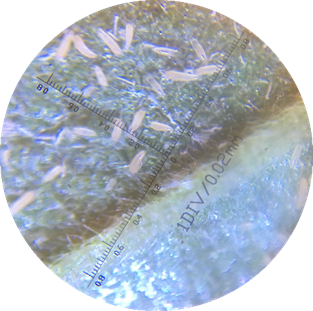
Hemp Russet Mites
What to look for: Leaf 'taco'-ing or yellowing at leaf edges.
Spread: Easily spread onto clones, clothing, and will travel on the wind. Invisible to the naked eye.
Home Remedies: Regularly inspect and quarantine new plants before introducing them to your garden. Washing plants with a strong stream of water can help dislodge mites. A simple mixture of liquid dish soap and water can be sprayed on plants to suffocate pests. Neem oil and other essential oils are a natural repellent and pesticide that can be mixed with water and liquid soap to create a spray for pests. Diatomaceous Earth is also effective, the abrasive substance can be sprinkled around plants to dehydrate the exoskeleton of insects.
Natural Solutions:
Anso-Mite (Amblyseius andersoni): This species is effective against thrips, two-spotted spider mites, broad mites, and russet mites. It can be used in both greenhouse and outdoor environments and is designed to perform consistently under different climatic conditions.
Swirskii-Mite (Amblyseius swirskii): This species is effective against thrips, whiteflies, broad mites, russet mites, and two-spotted spider mites. It can be used in both greenhouse and outdoor environments and is designed to perform consistently under various climatic conditions. Spical Sachets
Spical (Amblyseius californicus): This species targets two-spotted spider mites, thrips, whiteflies, broad mites, and russet mites. It is suitable for use in both greenhouse and outdoor settings and is resistant to low and high humidity.
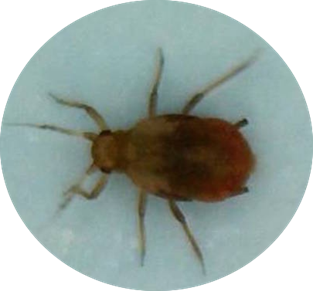
Root Aphids
What to look for: Leaf chlorosis (yellowing) and reduction in yield.
Identification: Both winged and non-winged aphid adults crawl around pots and stems.
Spread: Spread primarily through contaminated soil.
Home Remedies: Drenching the soil with a solution of water and hydrogen peroxide can help kill root aphids.
Natural Solutions:
Entomite-M (Stratiolaelaps scimitus): This soil-dwelling mite is a generalist predator that feeds on immature root aphids, fungus gnat larvae, and other small insects in the substrate. It is effective in both greenhouse and outdoor environments and can tolerate low soil moisture levels.
Atheta - Dalotia coriaria (Rove Beetle): Dalotia Coriaria is a predatory beetle that preys on larvae in the soil. The rove beetly can fly, giving it the ability to reach places difficult for humans and sprays to identify and treat. The rove beetle is a versatile predator that targets root aphids, fungus gnats, and thrips. It is highly effective in various environments, including greenhouses and outdoor crops. The beetle’s larvae and adults actively hunt and consume pests, providing continuous control.
Entonem - Steinernema feltiae (Nematode): These beneficial nematodes are effective against root aphids by parasitizing and killing them. They are applied to the soil and can be used in both greenhouse and outdoor settings. The nematodes seek out and infect root aphids, leading to their death.
Isarid (Isaria fumosorosea): This entomopathogenic fungus is effective against root aphids by infecting and killing them. It can be applied to the soil and is suitable for use in both greenhouse and outdoors. The fungus penetrates the aphid’s body, causing death and providing long-term control.
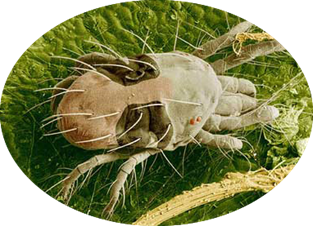
Two-Spotted Spider Mites
What to look for: Leaf stippling and webbing.
Conditions: Spider mites thrive in high heat and low humidity.
Home Remedies: Increase humidity around the plants and regularly spray them with water to deter spider mites. A simple mixture of liquid dish soap and water can be sprayed on plants to suffocate pests. Neem oil and other essential oils are a natural repellent and pesticide that can be mixed with water and liquid soap to create a spray for pests. Diatomaceous Earth is also effective, the abrasive substance can be sprinkled around plants to dehydrate the exoskeleton of insects.
Natural Solutions:
Spical (Amblyseius californicus): This species, available in sachets and bottles, targets two-spotted spider mites, thrips, whiteflies, broad mites, and russet mites. It is resistant to low and high humidity, making it versatile for various climatic conditions.
Spidex (Phytoseiulus persimilis): This species, available in sachets and bottles, targets two-spotted spider mites. It is best used in hot and humid conditions.
Swirskii Mite(Amblyseius swirskii): This species is effective against thrips, whiteflies, broad mites, russet mites, and two-spotted spider mites. It can survive on pollen or other prey, allowing it to establish in crops before pests appear. It has a wide temperature tolerance.
Anso-Mite (Amblyseius andersoni): This species is effective against thrips, two-spotted spider mites, broad mites, and russet mites. It can feed on pollen, allowing it to establish in crops before pests appear. It is designed to perform consistently under different climatic conditions.
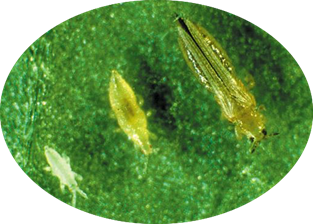
Western Flower Thrips
What to look for: Blotchy feeding damage and black spots from frass (waste products).
Life cycle: Thrips have 5 distinct life cycles, making control complex.
Reproduction: Incredibly high reproductive potential makes early action critical.
Home Remedies: Regularly inspect and remove affected plant parts. A simple mixture of liquid dish soap and water can be sprayed on plants to suffocate pests. Neem oil and other essential oils are a natural repellent and pesticide that can be mixed with water and liquid soap to create a spray for pests. Diatomaceous Earth is also effective, the abrasive substance can be sprinkled around plants to dehydrate the exoskeleton of insects.
Natural Solutions:
Swirski-Mite(Amblyseius swirskii): This species is effective against thrips, whiteflies, broad mites, russet mites, and two-spotted spider mites. It can be used in both greenhouse and outdoor environments and is designed to perform consistently under various climatic conditions.
Entomite-M (Stratiolaelaps scimitus): This soil-dwelling mite is a generalist predator that feeds on thrips, root aphids, and fungus gnats. It is effective in both greenhouse and outdoor environments and can tolerate low soil moisture levels.
Entonem (Steinernema feltiae): These beneficial nematodes are effective against thrips, fungus gnats, beetles, and caterpillars. They are applied to the soil and can be used in both greenhouse and outdoor settings.
Thripor (Orius insidiosus): This predatory bug targets thrips. It is suitable for use in both greenhouse and outdoor environments.
Thripex (Neoseiulus cucumeris): This predatory mite is effective against thrips and mite species. Thripex is a great cold-weather alternative to Swirskii. We also have Thripex sachets specifically designed with sticks for placement in nursery settings and propogation zones.
Isarid (Isaria fumosorosea): This entomopathogenic fungus is effective against thrips, whiteflies, aphids, mealybugs, fungus gnats, weevils, Lygus, leafhoppers, and Engytatus. It can be applied to the soil as well as the foliage and is suitable for use in both greenhouse and outdoor environments.
Anso-Mite (Amblyseius andersoni): This species is effective against thrips, two-spotted spider mites, broad mites, and russet mites. It can be used in both greenhouse and outdoor environments and is designed to perform consistently under different climatic conditions.








